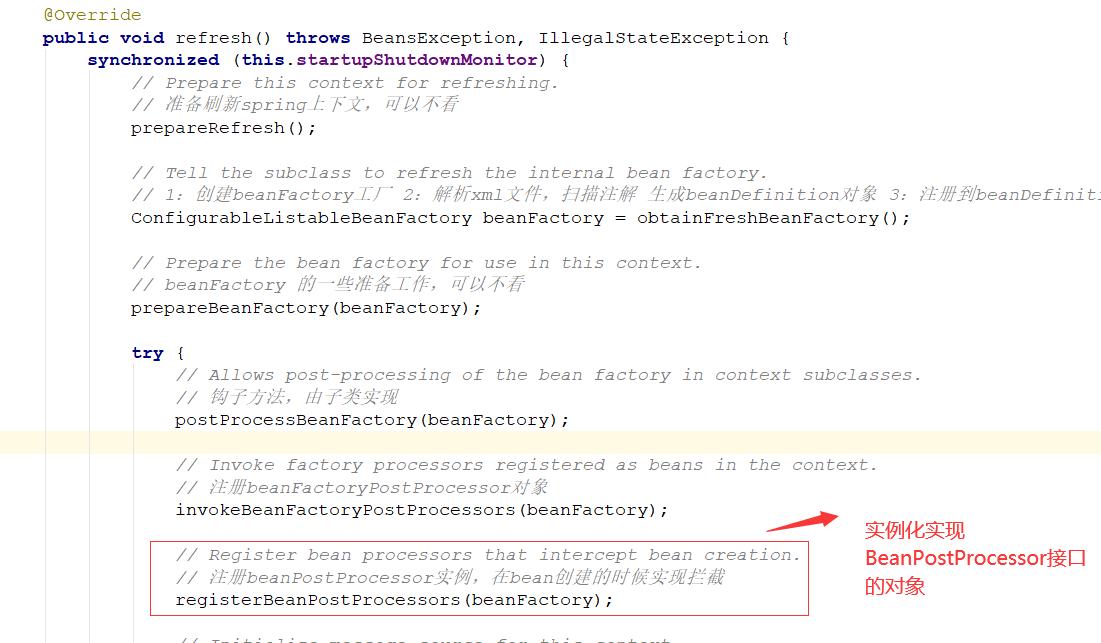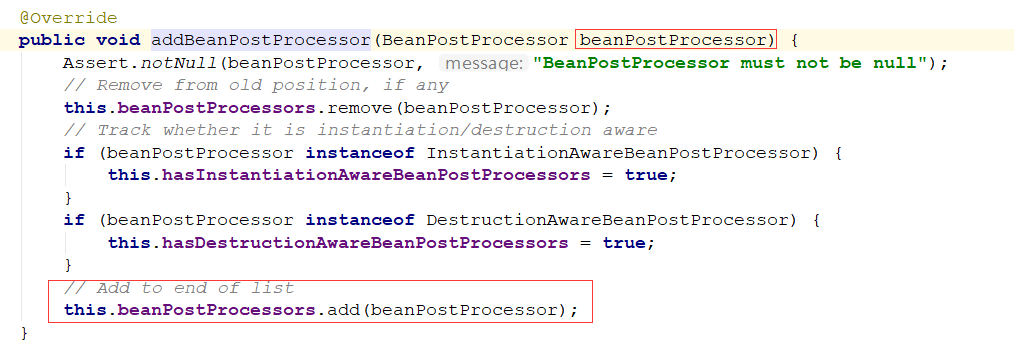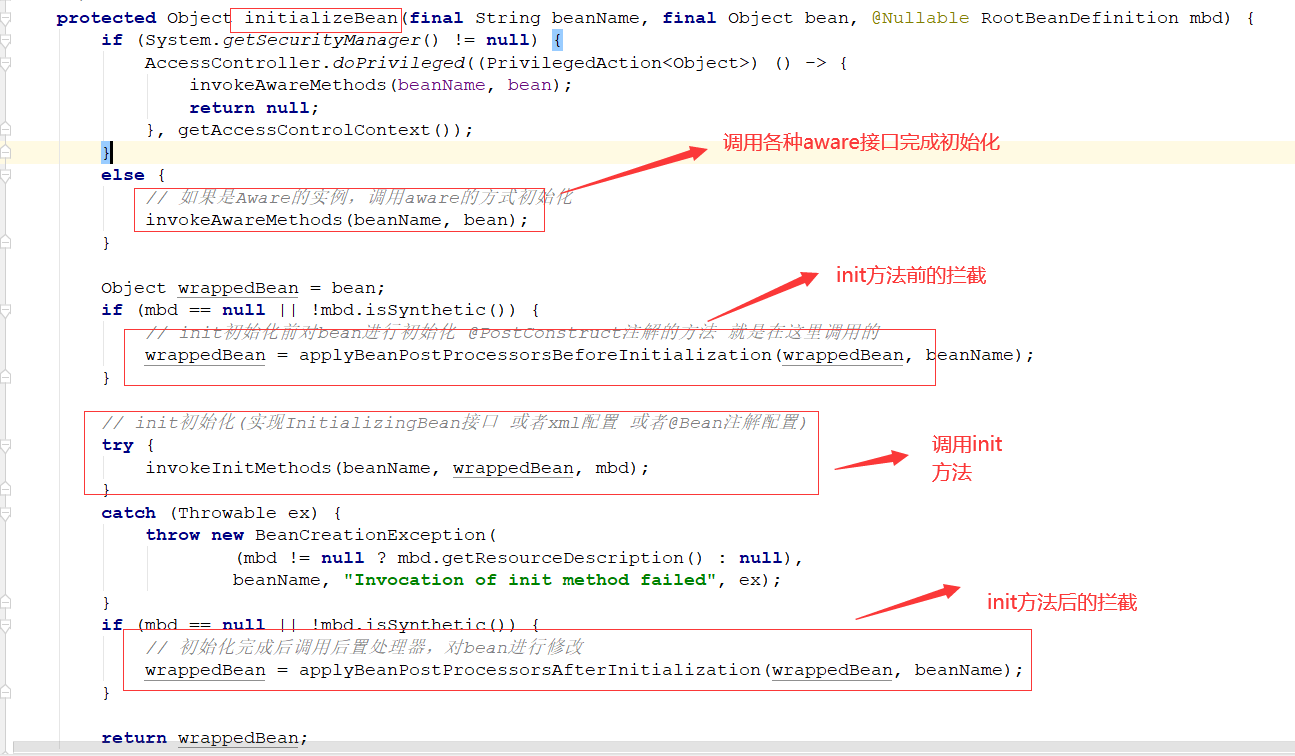spring原始碼分析——BeanPostProcessor介面
BeanPostProcessor是處理bean的後置介面,beanDefinitionMaps中的BeanDefinition例項化完成後,完成populateBean,屬性設定,完成
初始化後,這個介面支援對bean做自定義的操作。
一:BeanPostProcessor的使用
定義一個測試用的model物件,name屬性預設為hello
public class BeanDemo {
private String name = "hello";
public String getName() {
return name;
}
public void setName(String name) {
this.name = name;
}
@Override
public String toString() {
final StringBuffer sb = new StringBuffer("BeanDemo{");
sb.append("name='").append(name).append('\'');
sb.append('}');
return sb.toString();
}
}
自定義一個MyBeanPostProcessor類,實現BeanPostProcessor介面
@Service
public class MyBeanPostProcessor implements BeanPostProcessor {
public Object postProcessBeforeInitialization(Object bean, String beanName) throws BeansException {
return null;
}
public Object postProcessAfterInitialization(Object bean, String beanName) throws BeansException {
if(beanName.equals("beanDemo")){
BeanDemo beanDemo = (BeanDemo)bean;
beanDemo.setName("kitty");
return beanDemo;
}
return bean;
}
}

從執行結果看,spring中維護的beanName為beanDemo的物件,name屬性為ketty

二:看看原始碼怎麼實現的
1:例項化並且註冊到beanPostProcessors集合中


主要的例項化邏輯在這個介面,這個介面的作用就是把所有實現BeanPostProcessor介面的類例項化,然後註冊到 beanPostProcessors這個快取中

public static void registerBeanPostProcessors(
ConfigurableListableBeanFactory beanFactory, AbstractApplicationContext applicationContext) {
// 獲取所有實現介面BeanPostProcessor的beanName
String[] postProcessorNames = beanFactory.getBeanNamesForType(BeanPostProcessor.class, true, false);
// Register BeanPostProcessorChecker that logs an info message when
// a bean is created during BeanPostProcessor instantiation, i.e. when
// a bean is not eligible for getting processed by all BeanPostProcessors.
int beanProcessorTargetCount = beanFactory.getBeanPostProcessorCount() + 1 + postProcessorNames.length;
beanFactory.addBeanPostProcessor(new BeanPostProcessorChecker(beanFactory, beanProcessorTargetCount));
// Separate between BeanPostProcessors that implement PriorityOrdered,
// Ordered, and the rest.
/**
* 把實現PriorityOrdered 和 Ordered 和 其他的處理器分開
*/
List<BeanPostProcessor> priorityOrderedPostProcessors = new ArrayList<>();
List<BeanPostProcessor> internalPostProcessors = new ArrayList<>();
List<String> orderedPostProcessorNames = new ArrayList<>();
List<String> nonOrderedPostProcessorNames = new ArrayList<>();
/**
* 1:遍歷集合postProcessorNames
* 2:判斷型別,如果是PriorityOrdered,則例項化物件放入priorityOrderedPostProcessors集合,
* Ordered 則放入orderedPostProcessorNames集合,其他的放入nonOrderedPostProcessorNames集合
*/
for (String ppName : postProcessorNames) {
if (beanFactory.isTypeMatch(ppName, PriorityOrdered.class)) {
BeanPostProcessor pp = beanFactory.getBean(ppName, BeanPostProcessor.class);
priorityOrderedPostProcessors.add(pp);
if (pp instanceof MergedBeanDefinitionPostProcessor) {
internalPostProcessors.add(pp);
}
}
else if (beanFactory.isTypeMatch(ppName, Ordered.class)) {
orderedPostProcessorNames.add(ppName);
}
else {
nonOrderedPostProcessorNames.add(ppName);
}
}
// First, register the BeanPostProcessors that implement PriorityOrdered.
// 首先對priorityOrderedPostProcessors集合中例項物件排序,然後註冊,放入beanFactory中快取下來
sortPostProcessors(priorityOrderedPostProcessors, beanFactory);
registerBeanPostProcessors(beanFactory, priorityOrderedPostProcessors);
// Next, register the BeanPostProcessors that implement Ordered.
// 然後再例項化實現Ordered介面的物件,完成註冊
List<BeanPostProcessor> orderedPostProcessors = new ArrayList<>();
for (String ppName : orderedPostProcessorNames) {
BeanPostProcessor pp = beanFactory.getBean(ppName, BeanPostProcessor.class);
orderedPostProcessors.add(pp);
if (pp instanceof MergedBeanDefinitionPostProcessor) {
internalPostProcessors.add(pp);
}
}
sortPostProcessors(orderedPostProcessors, beanFactory);
registerBeanPostProcessors(beanFactory, orderedPostProcessors);
// Now, register all regular BeanPostProcessors.
// 最後例項化什麼都沒有實現的,完成例項化並註冊
List<BeanPostProcessor> nonOrderedPostProcessors = new ArrayList<>();
for (String ppName : nonOrderedPostProcessorNames) {
BeanPostProcessor pp = beanFactory.getBean(ppName, BeanPostProcessor.class);
nonOrderedPostProcessors.add(pp);
if (pp instanceof MergedBeanDefinitionPostProcessor) {
internalPostProcessors.add(pp);
}
}
registerBeanPostProcessors(beanFactory, nonOrderedPostProcessors);
// Finally, re-register all internal BeanPostProcessors.
// 最後再次註冊內部postProcessor
sortPostProcessors(internalPostProcessors, beanFactory);
registerBeanPostProcessors(beanFactory, internalPostProcessors);
// Re-register post-processor for detecting inner beans as ApplicationListeners,
// moving it to the end of the processor chain (for picking up proxies etc).
beanFactory.addBeanPostProcessor(new ApplicationListenerDetector(applicationContext));
}

定義四類容器,高優先順序有序、有序、無序、內部

分類放入四種容器:

註冊BeanPostProcessor,將實現BeanPostProcessor介面的物件放入beanPostProcessors快取中



註冊完PriorityOrdered的實現類後,再處理Ordered的實現類

註冊什麼都沒有實現的BeanPostProcessor介面實現類,

最後註冊內部的BeanPostProcessor物件

到這裡BeanPostProcessor的例項化以及註冊工作完成,在beanFactory的beanPostProcessors集合中已經快取了所有的beanPostProcessor的物件
2:BeanPostProcessor的使用
因為這個介面是bean的後置介面,所以需要bean建立並初始化完成,才可以發揮作用,上一步的快取只是埋好點,以備使用,因為bean的例項化流程我們
還沒有分析,這裡直接看一下怎麼使用的

我們看一下init方法後的攔截,因為這個時候已經init完成,可以在後置介面中對bean做一下修改的操作

呼叫到我們自定義的MyBeanPostProcessor實現類:

把這個beanDemo物件屬性修改一下,修改完,再返回,將這個物件快取到spring的一級快取中。

總結:
BeanPostProcessor介面主要是對bean物件做一些自定義的操作,修改bean物件的資訊,aop代理也是通過這種方式實現的,
在refresh的registryBeanPostProcessor方法中例項化BeanPostProcessor物件,並且註冊到beanFactory容器的beanPostProcessors的快取中,
然後在後續的操作中攔截使用。
&n
